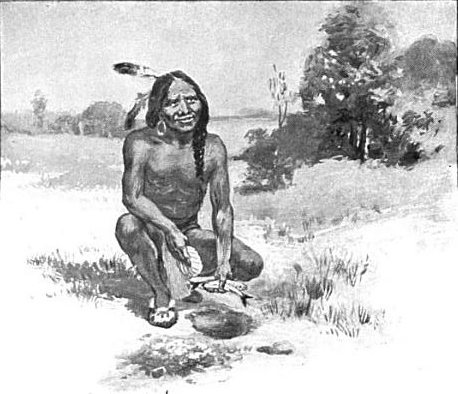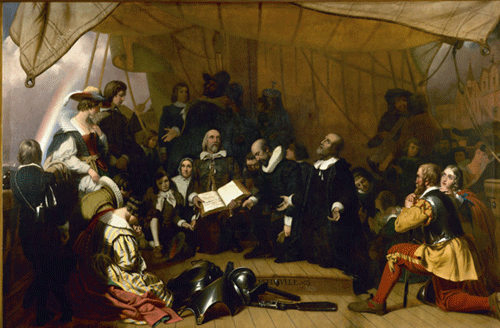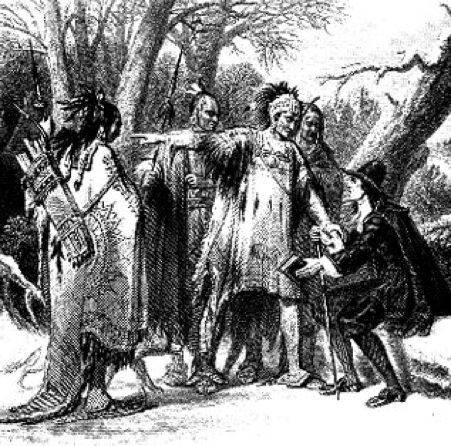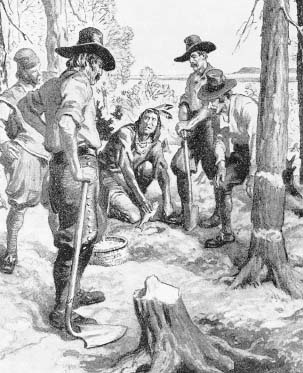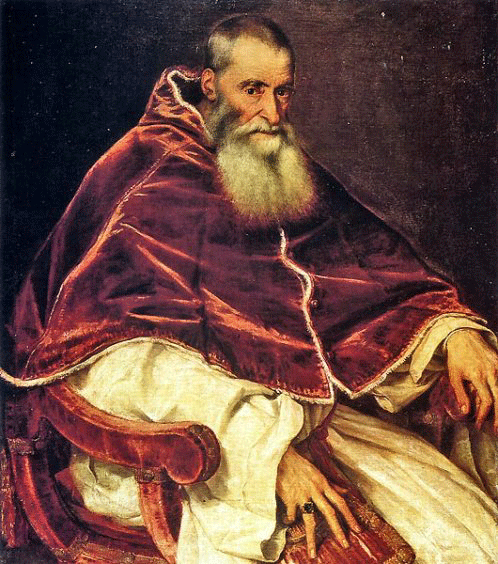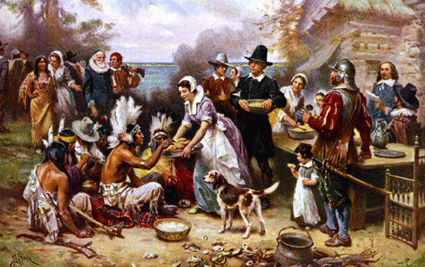Squanto: ‘… primary force behind the Pilgrims' unlikely survival in the New World’The True Story of Thanksgiving: Squanto, The Pilgrims and The Pope
PILGRIMS' PROGRESS
When the Pilgrims stepped off the Mayflower on December 11, 1620, they were not at all prepared for life in the New World. They were originally destined to colonize what is now Virginia, but the Mayflower veered badly off course. They also considered settling at the mouth of the Hudson River in modern day New York, but Dutch traders conspired to prevent it.
Before leaving England on September 16, 1620, the Pilgrims used their meager resources to purchase a second ship to sail along with the Mayflower and remain with them in the New World. That vessel was called the Speedwell. It was anything but well, however, nor was it speedy. Just 200 miles off the English coast, the Speedwell was sinking. Those aboard had to transfer to the crowded Mayflower while the Speedwell returned to England. There was evidence that the Speedwell was intentionally rigged to fail, leaving the colonists with no vessel with which to explore once the Mayflower departed.
The voyage across the Atlantic was delayed for months, finally landing the Pilgrims in New England at the start of winter. There were 102 aboard the Mayflower when it left England, but by the end of their first winter in the New World, only half that number were still alive. Unable to plant in the dead of winter, their first encounter with the indigenous people of coastal Massachusetts--known to those who lived there as "The Dawn Land"--came when the near starving Pilgrims stole ten bushels of maize from an Indian storage site on Cape Cod. It was not a good beginning.
Massasoit, the "sachem" (leader) of the once powerful Wampanoag tribe, was not at all enamored of the visitors, and the fact that they seemed intent on staying disturbed him greatly. The Pilgrims had no way to know that prior European visitors to those shores left diseases to which the people of The Dawn Land had no natural resistance. By the time the Pilgrims arrived, 95% of the indigenous population of New England, including the Wampanoag, had been decimated.
Still, Massasoit could have easily overtaken and destroyed the invaders, who were barely surviving, but they had something he wanted. Massasoit feared that his tribe's weakened state might spark an invasion from rivals to the south, and he noted that the Pilgrims had a few cannons and guns that could help even the odds.
THE PILGRIMS MEET ‘THE WRATH OF GOD’
So instead of attacking the Pilgrims, Massasoit sent an emissary in the person of Tisquantum, known to history as Squanto. He was actually a captive of Massasoit and arrived just weeks before the Pilgrims. Tisquantum was likely not his original name. In the language of the people of The Dawn Land, Tisquantum meant the equivalent of "the wrath of God." It may have been a name given to him, and, as you'll see below, perhaps for good reason.
Squanto was to become the primary force behind the Pilgrims' unlikely survival in the New World. On March 22, 1621, the vernal equinox, Squanto walked out of the forest into the middle of the Pilgrims' ramshackle base at Plymouth, a settlement known to Squanto as Patuxet. That place was once his home. To the Pilgrims' amazement, Squanto spoke nearly perfect English, and arrived prepared to remain with them and guide them through everything from fishing to agriculture to negotiations with the nervous and well-armed Massasoit and the Wampanoag.
As historian Charles C. Mann wrote in "Native Intelligence," (Smithsonian, December 2005), "Tisquantum was critical to the colony's survival." Squanto taught them to plant the native corn they had stolen instead of just eating it, and he negotiated a fair trade for the theft of the corn. The Pilgrims' own supplies of grain and barley all failed in the New World soil while the native corn gave them a life-saving crop. Squanto taught them how to fish, and how to fertilize the soil with the remains of the fish they caught. Most importantly, Squanto served as an advocate and interpreter for the Pilgrims with Massasoit, averting almost certain annihilation of the weakened and distrusted foreigners.
A CATHOLIC RESCUE
For their part, the Pilgrims interpreted Squanto's presence and intervention as acts of Divine Providence. They had no idea just how much Providence was involved. Thee story of Squanto--of how he came to be in that place at that very time, and of how he came to speak fluent English--is the most fascinating tale behind the first Thanksgiving.
In 1614, six years before the arrival of the Mayflower, Captain John Smith--the same man rescued by Pocahontas in another famous tale--led two British vessels to the coast of Maine to barter for fish and furs. When Smith departed from the Maine shore, he left a lieutenant, Thomas Hunt, in command to load his ship with dried fish.
Without consultation, Thomas Hunt sailed his ship south to what is now called Cape Cod Bay. Anchored off the coast of Patuxet (now Plymouth) in 1614, Hunt and his men invited two dozen curious native villagers aboard the ship. One of them was Squanto. Once aboard, the Indians--as the Europeans came to call them--were forced into irons in the ship's hold. Kidnapped from their homes and families, they were taken on a six-week journey across the Atlantic. Not all the captives survived the voyage. Those who did survive, Squanto among them, were brought to Malaga off the coast of Spain to be sold as slaves.
Fortunately for Squanto, and later for our Pilgrims, Spain was a Catholic country. Seventy-seven years earlier, envisioning injustices visited upon the indigenous peoples Of the New World, Pope Paul III issued "Sublimis Dei," a papal bull forbidding Catholic governments from enslaving or mistreating Indians from the Americas. The Pope declared that Indians are "true men" who could not lawfully be deprived of liberty. "Sublimis Dei" instructed that European intervention into the lives of Indians had to be motivated by benefit to the Indians themselves. It would take America another 300 years to catch up with the Catholic Church and abolish slavery.
As a result of the papal decree, the Catholic Church in Spain was opposed to the mistreatment of Indians, and opposed to bringing them to Europe against their will. Of course, the Catholic ideal did not always prevent slave trade on the black market. At Malaga, Thomas Hunt managed to sell most of his captives, and was about to sell Squanto when two Spanish Jesuit priests intervened. The Spanish speaking priests seized Squanto who somehow convinced them to send him home. Not knowing where "home" was, the priests arranged for Squanto's passage as a free man on a ship bound for London. It is likely that the Jesuits even baptized Squanto as a Catholic. It would have been a way to assure his status as a free man.
Squanto's world tour was underway. In late 1614, having no idea where he was, Squanto walked into the London office of John Slaney, manager of the Bristol Company, a shipping and merchant venture that had been given rights to the Isle of Newfoundland by England's King James I in 1610. He spent the next three years stranded in London before being placed on a ship bound for St. John's, Newfoundland in 1617. By now fully immersed in the language and ways of the English, Squanto spent another two years stranded in Newfoundland--1,000 miles of sea and rocky coast still separating him from his native Patuxet.
Late in 1619, Squanto befriended Thomas Dermer, a British Merchant in Newfoundland who agreed to sail Squanto home, though neither knew where home was. They knew it was south, so south they sailed. Squanto eventually recognized a Patuxet landmark - maybe even what we came to call Plymouth Rock.
With Thomas Dermer's ship anchored off Patuxet, Squanto stepped onto the shores of home after a nearly six year absence. But the people of The Dawn Land--Squanto's people--were no more. Squanto was devastated to learn that disease had ravaged his home in his absence, and not a single Patuxet native had survived. Squanto was alone.
Squanto knew he could not remain there. He convinced Thomas Dermer to accompany him inland in search of anyone among his people who might have survived. There was no one. It wasn't long before both men were taken captive by Massasoit, sachem of what had been a confederation of 20,000 native Massachuset and Wampanoag tribal peoples. By the time Squanto and Thomas Dermer stood captive before Massasoit, however, all but 1,000 of them were dead from diseases carried to the New World aboard European vessels.
Just weeks later, it was to this setting that the Mayflower's naive and ill-prepared Pilgrims arrived to face the winter of 1620 in the New World. Squanto, now alone--his life ravaged and his home and people destroyed--convinced Massasoit to send him to the Pilgrims as a negotiator and interpreter instead of attacking them. Squanto put his wrath aside, and became a bridge linking two disparate worlds.
Without Squanto--and, indirectly at least, the Pope and some Jesuit priests--the fate of the Puritan Pilgrims would have been vastly different, and Thanksgiving would likely have never taken place. Squanto was, as Governor William Bradford of Plymouth Plantation wrote of him, "A spetiall instrument sent of God for their good beyond their expectations."
On that point, both Puritans and Catholics might agree. At your Thanksgiving table this year, say a prayer of thanks for Tisquantum--Squanto. Our national ancestors were once pilgrims and strangers in a strange land, and that land's most disenfranchised citizen assured their survival.
(excerpt from Fr. MacRae's blog at These Stone Walls: Musings From Prison of a Priest Falsely Accused. For more information and to contribute to Fr. MacRae's defense fund visit These Stone Walls, where Ryan A. MacDonald's article "Truth In Justice: Was the Wrong Catholic Priest Sent to Prison?" is posted.)
Founder/Publisher/Editor: David McGee
Contributing Editors: Billy Altman, Laura Fissinger, Christopher Hill, Derk Richardson
Logo Design: John Mendelsohn (www.johnmendelsohn.com)
Website Design: Kieran McGee (www.kieranmcgee.com)
Staff Photographers: Audrey Harrod (Louisville, KY; www.flickr.com/audreyharrod), Alicia Zappier (New York)
E-mail: thebluegrassspecial@gmail.com
Mailing Address: David McGee, 201 W. 85 St.—5B, New York, NY 10024


